A Comparison of IPCC Guidelines and Allocation Methods to Estimate the Environmental Impact of Barley Production in the Basque Country through Life Cycle Assessment (LCA)
Abstract
:1. Introduction
2. Materials and Methods
2.1. Goal and Scope Definition
2.2. Characteristics of the Study Area
2.3. System Boundaries and Functional Unit
2.4. Allocation Procedure
2.5. Life Cycle Inventory (LCI)
2.5.1. Emissions from Seed, Fertiliser, and Pesticide Production
2.5.2. Emissions from Agricultural Field Operations (Fuel Consumption)
2.5.3. Emissions from Field
2.6. Life Cycle Impact Assessment (LCIA)
- •
- Climate change (CC, kg CO2 eq);
- •
- Ozone depletion (OD, kg chlorofluorocarbons-11 equivalents, kg CFC-11 eq);
- •
- Human toxicity–no cancer effect (HTnoc, comparative toxic unit for human, CTUh);
- •
- Human toxicity–cancer effect (HTC, comparative toxic unit for human, CTUh);
- •
- Particulate matter formation (PM, kg 2.5 particulate matter equivalents, kg PM 2.5 eq);
- •
- Photochemical ozone formation (POF, kg non-methane volatile organic compounds equivalents, kg NMVOC eq);
- •
- Terrestrial acidification (TA, molc H+ eq);
- •
- Terrestrial eutrophication (TE, molc N eq);
- •
- Freshwater eutrophication (FE, kg P eq);
- •
- Marine eutrophication (ME, kg N eq);
- •
- Freshwater ecotoxicity (FEx, comparative toxic units ecotoxicity, CTUe);
- •
- Mineral, fossil, and renewable resource depletion (MFRD, kg antimony equivalents, kg Sb eq).
2.7. Sensitivity Analysis
3. Results
3.1. Environmental Impacts of Barley Production in Araba/Álava
3.2. Relative Contribution of Agricultural Management Inputs and Activities on Climate Change Impact
3.3. Sensitivity Analysis of the Climate Change Impact Category to Allocation Types and Emission Factors
4. Discussion
4.1. Environmental Impacts of Barley Production in Araba/Álava
4.2. Relative Contributions of Inputs and Activities to Estimated Climate Change Impact
4.3. Sensitivity Analysis
4.4. Future Research Directions
5. Conclusions
Author Contributions
Funding
Institutional Review Board Statement
Informed Consent Statement
Data Availability Statement
Acknowledgments
Conflicts of Interest
Appendix A
| Field | Surface | Yield | NAC | NPK Mixtures 1 | AS | AN 33% | a.i. 2 | Diesel Consumption |
|---|---|---|---|---|---|---|---|---|
| No | ha | kg ha−1 | ||||||
| 1 | 3.55 | 4800 | 440 | 9-24-10; (392) | 0.609 | 53.71 | ||
| 2 | 3.13 | 5000 | 400 | 10-20-6; (400) 10-23-9; (400) | 0.069 | 46.16 | ||
| 3 | 4.00 | 5025 | 360 | 21-6-9; (400) | 0.788 | 57.75 | ||
| 4 | 3.55 | 7160 | 460 | 13-20-06; (400) | 0.571 | 90.86 | ||
| 5 | 3.65 | 6910 | 13-20-06; (440) | 450 | 0.140 | 117.83 | ||
| 6 | 3.13 | 7800 | 310 | 13-20-06; (440) | 250 | 0.413 | 46.96 | |
| 7 | 5.41 | 7000 | 400 | 7-10-06; (500) | 0.218 | 32.76 | ||
| 8 | 2.57 | 5837 | 320 | 8-15-15; (500) | 360 | 2.538 | 86.61 | |
| 9 | 4.00 | 5800 | 20-10-5, (400) | 360 | 0.180 | 75.60 | ||
| 10 | 3.59 | 7075 | 250 | 13-20-06; (364) | 230 | 0.195 | 56.39 | |
| 11 | 2.07 | 5600 | 13-20-06; (440) | 450 | 0.271 | 120.93 | ||
| 12 | 8.66 | 7000 | 300 | 13-20-06; (440) | 250 | 0.354 | 42.29 | |
| 13 | 7.99 | 5000 | 400 | 13-20-06; (440) | 0.350 | 40.69 | ||
| 14 | 4.74 | 5169 | 400 | 20-07-06; (400) | 0.531 | 43.59 | ||
| 15 | 2.57 | 7200 | 13-20-06; (400) | 400 | 0.318 | 69.29 | ||
| 16 | 3.43 | 6900 | 368 | 13-20-06; (380) | 0.323 | 50.45 | ||
| 17 | 5.24 | 6240 | 350 | 20-10-05; (400) | 0.369 | 43.28 | ||
References
- FAOSTAT. Available online: http://www.fao.org/faostat/en/#data/QC/visualize (accessed on 2 June 2021).
- Eurostat. Available online: https://ec.europa.eu/eurostat/databrowser/view/tag00051/default/table?lang=en (accessed on 2 June 2021).
- Organo Estadístico Departamental del Gobierno Vasco. Available online: https://www.euskadi.eus/web01-ejeduki/es/contenidos/estadistica/estadistica_rapida_agrario/es_dapa/index.shtml (accessed on 15 June 2021).
- Noya, I.; González-García, S.; Bacenetti, J.; Arroja, L.; Moreira, M.T. comparative life cycle assessment of three representative feed cereals production in the Po Valley (Italy). J. Clean. Prod. 2015, 99, 250–265. [Google Scholar] [CrossRef]
- ISO 14040 Environmental Management—Life Cycle Assessment—Principles and Framework. 2006. Available online: https://www.iso.org/cms/render/live/en/sites/isoorg/contents/data/standard/03/74/37456.html (accessed on 6 May 2021).
- Notarnicola, B.; Sala, S.; Anton, A.; McLaren, S.J.; Saouter, E.; Sonesson, U. The role of life cycle assessment in supporting sustainable agri-food systems: A review of the challenges. J. Clean. Prod. 2017, 140, 399–409. [Google Scholar] [CrossRef]
- Tricase, C.; Lamonaca, E.; Ingrao, C.; Bacenetti, J.; Lo Giudice, A. A comparative life cycle assessment between organic and conventional barley cultivation for sustainable agriculture pathways. J. Clean. Prod. 2018, 172, 3747–3759. [Google Scholar] [CrossRef]
- Tidåker, P.; Bergkvist, G.; Bolinder, M.; Eckersten, H.; Johnsson, H.; Kätterer, T.; Weih, M. Estimating the environmental footprint of barley with improved nitrogen uptake efficiency—A Swedish scenario study. Eur. J. Agron. 2016, 80, 45–54. [Google Scholar] [CrossRef]
- Gan, Y.; Liang, C.; May, W.; Malhi, S.S.; Niu, J.; Wang, X. Carbon footprint of spring barley in relation to preceding oilseeds and n fertilization. Int. J. Life Cycle Assess. 2012, 17, 635–645. [Google Scholar] [CrossRef]
- Lovarelli, D.; Garcia, L.R.; Sánchez-Girón, V.; Bacenetti, J. Barley production in Spain and Italy: Environmental comparison between different cultivation practices. Sci. Total Environ. 2020, 707, 135982. [Google Scholar] [CrossRef] [PubMed]
- Niero, M.; Ingvordsen, C.H.; Peltonen-Sainio, P.; Jalli, M.; Lyngkjær, M.F.; Hauschild, M.Z.; Jørgensen, R.B. Eco-efficient production of spring barley in a changed climate: A life cycle assessment including primary data from future climate scenarios. Agric. Syst. 2015, 136, 46–60. [Google Scholar] [CrossRef] [Green Version]
- Schmidt Rivera, X.C.; Bacenetti, J.; Fusi, A.; Niero, M. The influence of fertiliser and pesticide emissions model on life cycle assessment of agricultural products: The case of Danish and Italian barley. Sci. Total Environ. 2017, 592, 745–757. [Google Scholar] [CrossRef] [PubMed] [Green Version]
- Dijkman, T.J.; Birkved, M.; Saxe, H.; Wenzel, H.; Hauschild, M.Z. Environmental impacts of barley cultivation under current and future climatic conditions. J. Clean. Prod. 2017, 140, 644–653. [Google Scholar] [CrossRef] [Green Version]
- Suh, S.; Weidema, B.; Schmidt, J.H.; Heijungs, R. Generalized Make and Use Framework for allocation in life cycle assessment. J. Ind. Ecol. 2010, 14, 335–353. [Google Scholar] [CrossRef]
- MAPA Sistema de Información Geográfica de Datos Agrarios (SIGA). Available online: https://www.mapa.gob.es/es/agricultura/temas/sistema-de-informacion-geografica-de-datos-agrarios/default.aspx (accessed on 4 June 2021).
- IPCC. 2019 Refinement to the 2006 IPCC Guidelines for National Greenhouse Gas Inventories; Calvo Buendia, E., Tanabe, K., Kranjc, A., Baasansuren, J., Fukuda, M., Ngarize, S., Osako, A., Pyrozhenko, Y., Shermanau, P., Federici, S., Eds.; IPCC: Geneva, Switzerland, 2019. [Google Scholar]
- Eggleston, S.; Buendia, L.; Miwa, K.; Ngara, T.; Tanabe, K. (Eds.) IPCC Guidelines for National Greenhouse Gas Inventories; IGES: Hayama, Japan, 2006. [Google Scholar]
- Environdec Product Category Rules for Arable and Vegetable Crops; Product Category Classification: UN CPC 011, 012, 014, 017, 0191. PCR 2020-07 (VERSION 1.0); EPD International: Stockholm, Sweden, 2020.
- Ardente, F.; Cellura, M. Economic allocation in life cycle assessment. J. Ind. Ecol. 2012, 16, 387–398. [Google Scholar] [CrossRef]
- Nekazaritza Elikagaien. Behatokia Observatorio Del Sector Agroalimentario Vasco (2009–2014). Departamento de Desarrollo Económico, Sostenibilidad y Medio Ambiente del Gobierno Vasco. Available online: https://www.euskadi.eus/gobierno-vasco/departamento-desarrollo-economico-infraestructuras/ (accessed on 30 August 2021).
- Nekazaritza Elikagaien. Behatokia Observatorio Del Sector Agroalimentario Vasco (2015–2020). Departamento de Desarrollo Económico, Sostenibilidad y Medio Ambiente del Gobierno Vasco. Available online: https://www.euskadi.eus/web01-s2ekono/es/contenidos/entidad/entity3ee14da4/es_def/index.shtml (accessed on 30 August 2021).
- IDEA. Available online: https://www.idae.es/home (accessed on 25 June 2021).
- Life AGROgestor Gestión Colectiva de Cultivos al Servicio de Programas Ambientales Relacionados con el Uso y la Calidad del Agua. Available online: https://www.agrogestor.es/ (accessed on 25 June 2021).
- Nemecek, T.; Heil, A.; Huguenin-Elie, O.; Meier, S.; Erzinger, S.; Blaser, S. Life cycle inventories of agricultural production systems. Final Rep. Ecoinvent 2004, 15, 145–146. [Google Scholar]
- Althaus, H.-J.; Doka, G.; Dones, R.; Heck, T.; Hellweg, S.; Hischier, R.; Nemecek, T.; Rebitzer, G.; Spielmann, M.; Wernet, G. Overview and Methodology; Final Report Ecoinvent Data v2.0, No. 1; Frischknecht, R., Jungbluth, N., Eds.; Swiss Centre for LCI: Dübendorf, Switzerland, 2007; p. 77. [Google Scholar]
- Nemecek, T.; Kägi, T. Life Cycle Inventories of Agricultural Production Systems; Final Report Ecoinvent V2.0 No. 15; Agroscope Reckenholz-Taenikon Research Station ART, Swiss Centre for Life Cycle Inventories: Zurich and Dübendorf, CH, 2007; Available online: Www.Ecoinvent.Ch (accessed on 6 May 2021).
- Spielmann, M.; Bauer, C.; Dones, R.; Tuchschmid, M. Transport Services; Ecoinvent Report No. 14; Swiss Centre for Life Cycle Inventories: Dübendorf, Switzerland, 2007. [Google Scholar]
- ISO 14044 Environmental Management—Life Cycle Assessment—Requirements and Guidelines. Available online: https://www.iso.org/obp/ui#iso:std:iso:14044:ed-1:v1:en (accessed on 17 June 2021).
- Renzulli, P.A.; Bacenetti, J.; Benedetto, G.; Fusi, A.; Ioppolo, G.; Niero, M.; Proto, M.; Salomone, R.; Sica, D.; Supino, S. Life cycle assessment in the cereal and derived products sector. In Life Cycle Assessment in the Agri-Food Sector: Case Studies, Methodological Issues and Best Practices; Notarnicola, B., Salomone, R., Petti, L., Renzulli, P.A., Roma, R., Cerutti, A.K., Eds.; Springer International Publishing: Cham, Switzerland, 2015; pp. 185–249. ISBN 978-3-319-11940-3. [Google Scholar]
- Peter, C.; Fiore, A.; Hagemann, U.; Nendel, C.; Xiloyannis, C. Improving the accounting of field emissions in the carbon footprint of agricultural products: A comparison of default IPCC methods with readily available medium-effort modeling approaches. Int. J. Life Cycle Assess. 2016, 21, 791–805. [Google Scholar] [CrossRef] [Green Version]
- Zampori, L.; Pant, R. Suggestions for Updating the Organisation Environmental Footprint (OEF) Method. EUR 29682 EN; Publications Office of the European Union: Luxembourg, 2019; ISBN 978-92-76-00654-1. [Google Scholar] [CrossRef]
- EMEP/EEA. Air Pollutant Emission Inventory Guidebook 2019—European Environment Agency. Technical Guidance to Prepare National Emission Inventories; EEA Technical Report No9/2009; European Environment Agency: Copenhagen, Denmark, 2019; Available online: https://www.eea.europa.eu/publications/emep-eea-guidebook-2019 (accessed on 6 May 2021).
- Prasuhn, V. Erfassung Der PO4-Austräge Für Die Ökobilanzierung SALCA Phosphor; Agroscope Reckenholz-Tänikon: Zurich, Switzerland, 2006. [Google Scholar]
- Brentrup, F.; Küsters, J.; Lammel, J.; Kuhlmann, H. Methods to estimate on-field nitrogen emissions from crop production as an input to LCA studies in the agricultural sector. Int. J. Life Cycle Assess. 2000, 5, 349. [Google Scholar] [CrossRef]
- Althaus, H.J.; Chudacoff, M.; Hischier, R.; Jungbluth, N.; Osses, M.; Primas, A.A. Life Cycle Inventories of Chemicals; Ecoinvent Report No. 8, v2.0; Swiss Centre of Life Cycle Inventories: Dübendorf, CH, 2007; Available online: Www.Ecoinvent.Org (accessed on 6 June 2021).
- Margni, M.; Rossier, D.; Crettaz, P.; Jolliet, O. Life cycle impact assessment of pesticides on human health and ecosystems. Agric. Ecosyst. Environ. 2002, 93, 379–392. [Google Scholar] [CrossRef]
- Buratti, C.; Fantozzi, F. Life cycle assessment of biomass production: Development of a methodology to improve the environmental indicators and testing with fiber sorghum energy crop. Biomass Bioenergy 2010, 34, 1513–1522. [Google Scholar] [CrossRef]
- Castanheira, É.G.; Dias, A.C.; Arroja, L.; Amaro, R. The environmental performance of milk production on a typical portuguese dairy farm. Agric. Syst. 2010, 103, 498–507. [Google Scholar] [CrossRef]
- González-García, S.; Bacenetti, J.; Negri, M.; Fiala, M.; Arroja, L. Comparative environmental performance of three different annual energy crops for biogas production in Northern Italy. J. Clean. Prod. 2013, 43, 71–83. [Google Scholar] [CrossRef]
- Roer, A.-G.; Korsaeth, A.; Henriksen, T.M.; Michelsen, O.; Strømman, A.H. The influence of system boundaries on life cycle assessment of grain production in Central Southeast Norway. Agric. Syst. 2012, 111, 75–84. [Google Scholar] [CrossRef]
- Bacenetti, J.; Fusi, A.; Negri, M.; Guidetti, R.; Fiala, M. environmental assessment of two different crop systems in terms of biomethane potential production. Sci. Total Environ. 2014, 466–467, 1066–1077. [Google Scholar] [CrossRef] [PubMed]
- Mogensen, L.; Kristensen, T.; Nguyen, T.L.T.; Knudsen, M.T.; Hermansen, J.E. Method for calculating carbon footprint of cattle feeds—Including contribution from soil carbon changes and use of cattle manure. J. Clean. Prod. 2014, 73, 40–51. [Google Scholar] [CrossRef]
- González-García, S.; Baucells, F.; Feijoo, G.; Moreira, M.T. Environmental performance of sorghum, barley and oat silage production for livestock feed using life cycle assessment. Resour. Conserv. Recycl. 2016, 111, 28–41. [Google Scholar] [CrossRef]
- Hauschild, M.; Goedkoop, M.; Guinee, J.; Heijungs, R.; Huijbregts, M.; Jolliet, O.; Margni, M.; De Schryver, A.; Pennington, D.; Pant, R.; et al. Recommendations for Life Cycle Impact Assessment in the European Context—Based on Existing Environmental Impact Assessment Models and Factors (International Reference Life Cycle Data System—ILCD Handbook). EUR 24571 EN; Publications Office of the European Union: Luxembourg, 2011. [Google Scholar]
- Commission of the European Union; Joint Research Centre; Institute for Environment and Sustainability; International Reference Life Cycle Data System (ILCD). Handbook: General Guide for Life Cycle Assessment: Provisions and Action Steps; Publications Office: Luxembourg, 2011. [Google Scholar]
- Bartzas, G.; Zaharaki, D.; Komnitsas, K. Life cycle assessment of open field and greenhouse cultivation of lettuce and barley. Inf. Process. Agric. 2015, 2, 191–207. [Google Scholar] [CrossRef] [Green Version]
- Guinée, J.B.; Huppes, G.; Heijungs, R. Developing an LCA guide for decision support. Environ. Manag. Health 2001, 12, 301–311. [Google Scholar] [CrossRef]
- Niero, M.; Ingvordsen, C.H.; Jørgensen, R.B.; Hauschild, M.Z. How to manage uncertainty in future life cycle assessment (LCA) scenarios addressing the effect of climate change in crop production. J. Clean. Prod. 2015, 107, 693–706. [Google Scholar] [CrossRef] [Green Version]
- Fedele, A.; Mazzi, A.; Niero, M.; Zuliani, F.; Scipioni, A. Can the life cycle assessment methodology be adopted to support a single farm on its environmental impacts forecast evaluation between conventional and organic production? An italian case study. J. Clean. Prod. 2014, 69, 49–59. [Google Scholar] [CrossRef]
- Hamelin, L.; Jørgensen, U.; Petersen, B.M.; Olesen, J.E.; Wenzel, H. Modelling the carbon and nitrogen balances of direct land use changes from energy crops in Denmark: A consequential life cycle inventory. GCB Bioenergy 2012, 4, 889–907. [Google Scholar] [CrossRef]
- Bacenetti, J.; Lovarelli, D.; Fiala, M. Mechanisation of organic fertiliser spreading, choice of fertiliser and crop residue management as solutions for maize environmental impact mitigation. Eur. J. Agron. 2016, 79, 107–118. [Google Scholar] [CrossRef]
- Hasler, K.; Bröring, S.; Omta, S.W.F.; Olfs, H.-W. Life cycle assessment (LCA) of different fertilizer product types. Eur. J. Agron. 2015, 69, 41–51. [Google Scholar] [CrossRef]
- Brentrup, F.; Küsters, J.; Lammel, J.; Barraclough, P.; Kuhlmann, H. environmental impact assessment of agricultural production systems using the life cycle assessment (LCA) methodology II. The application to N fertilizer use in winter wheat production systems. Eur. J. Agron. 2004, 20, 265–279. [Google Scholar] [CrossRef]
- Laegreid, M.; Bockman, O.C.; Kaarstad, O. Agriculture, Fertilizers and the Environment; CABI publishing: Wallingford, UK, 1999. [Google Scholar]
- Fallahpour, F.; Aminghafouri, A.; Ghalegolab Behbahani, A.; Bannayan, M. The environmental impact assessment of wheat and barley production by using life cycle assessment (LCA) methodology. Environ. Dev. Sustain. 2012, 14, 979–992. [Google Scholar] [CrossRef]
- Fusi, A. Improving Environmental Sustainability of the Agro-Food Sector through the Application of the LCA Methodology; Universitá Degli Studi Di Milano: Milano, Italy, 2014. [Google Scholar]
- Goglio, P.; Smith, W.N.; Grant, B.B.; Desjardins, R.L.; McConkey, B.G.; Campbell, C.A.; Nemecek, T. Accounting for soil carbon changes in agricultural life cycle assessment (LCA): A review. J. Clean. Prod. 2015, 104, 23–39. [Google Scholar] [CrossRef]
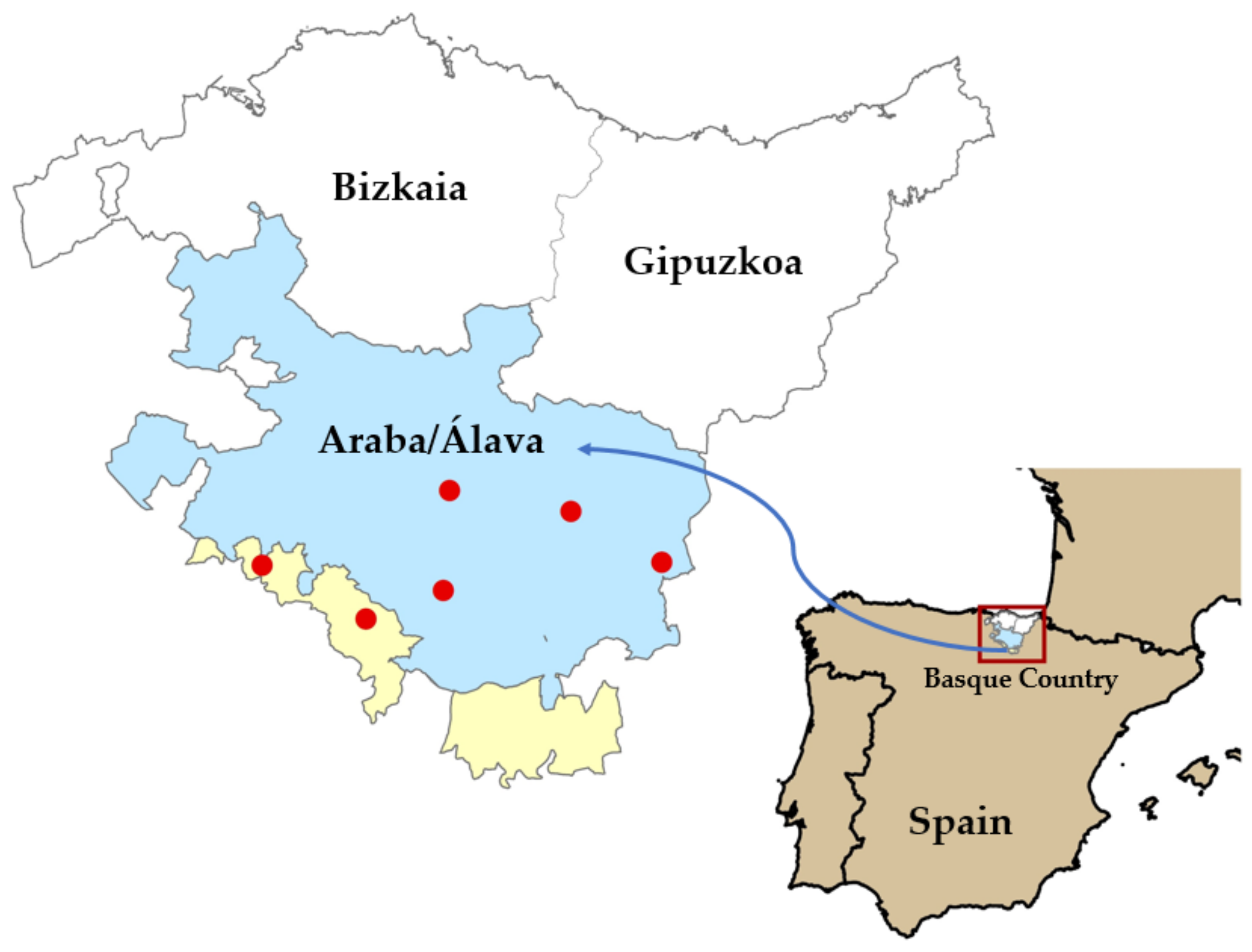
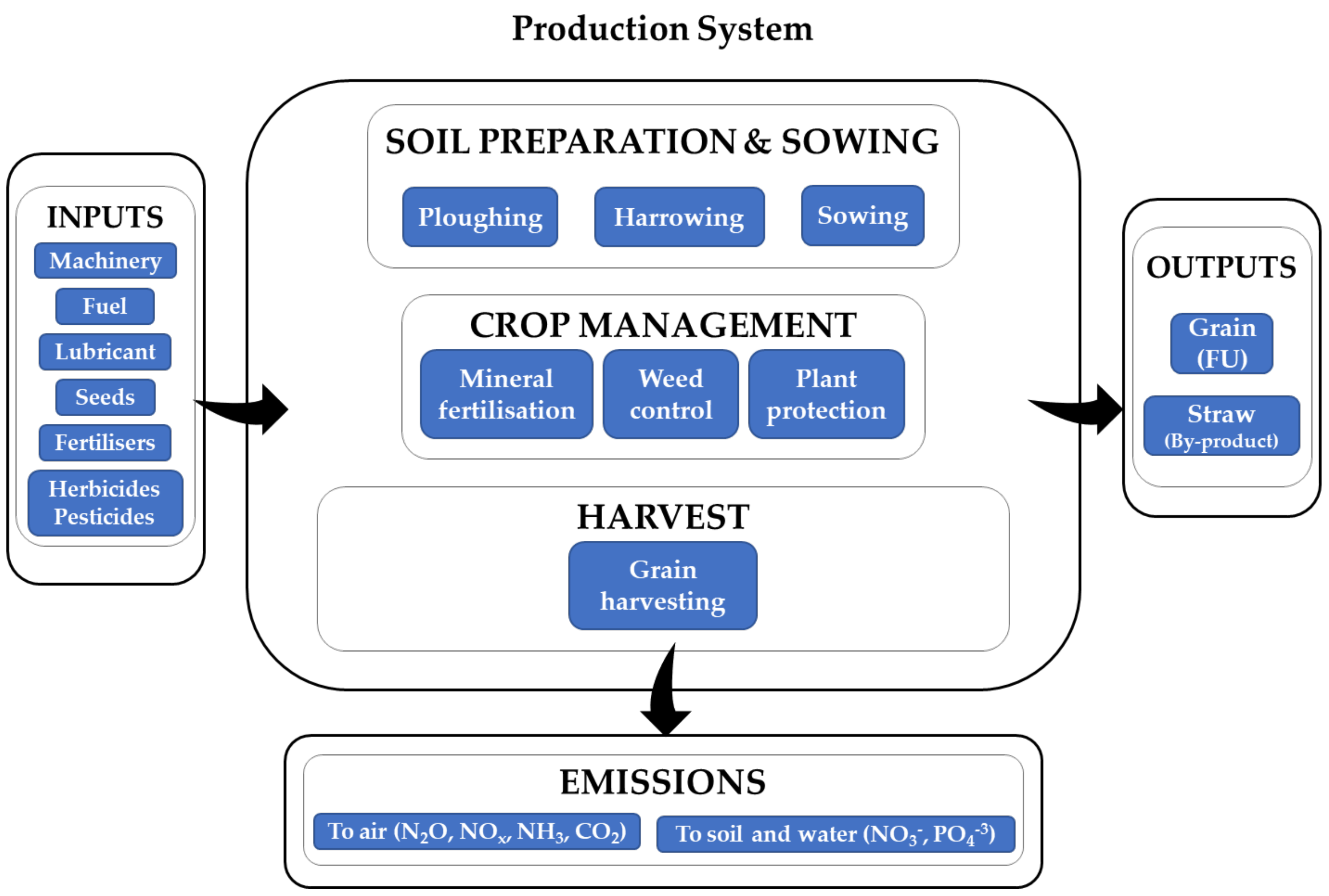
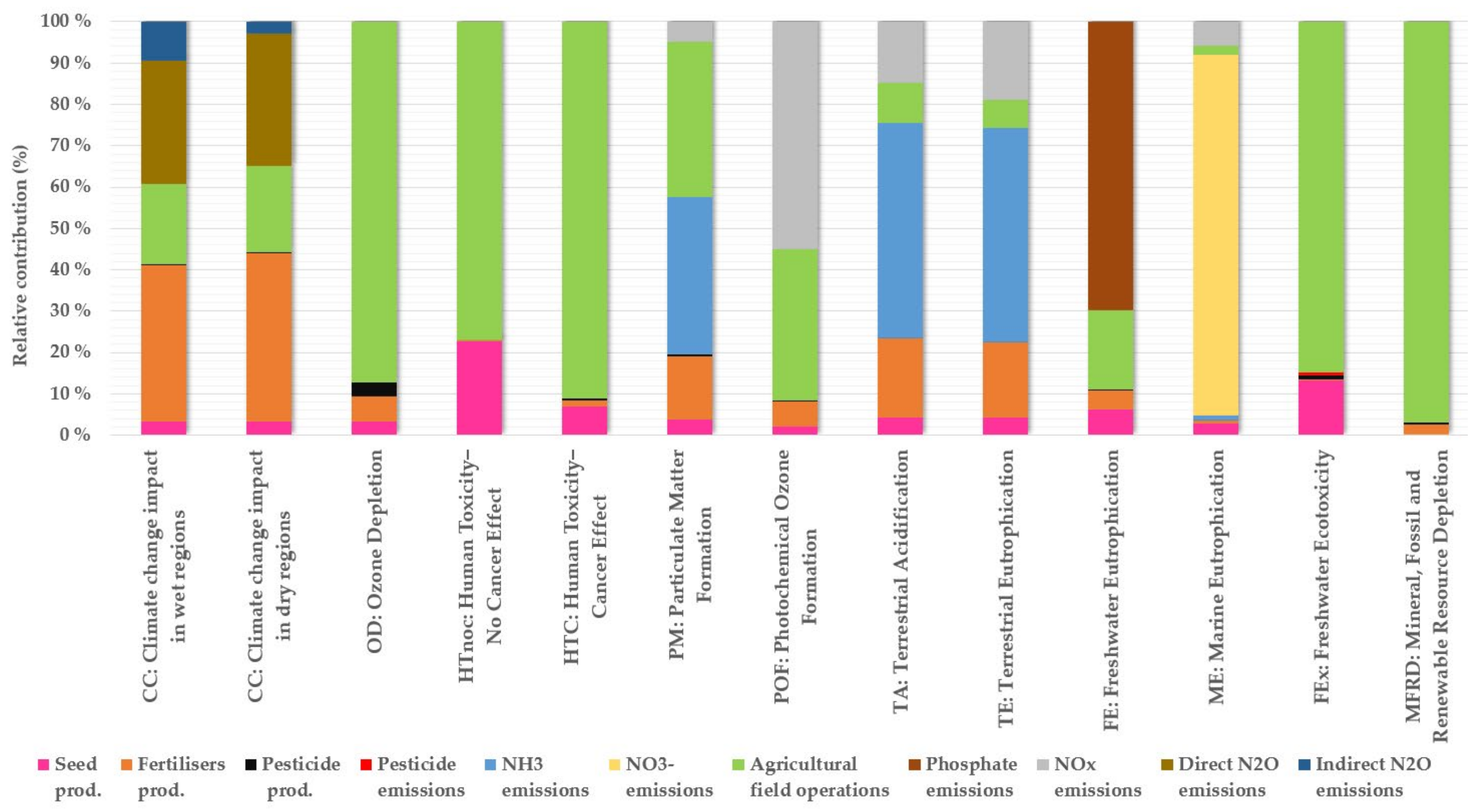
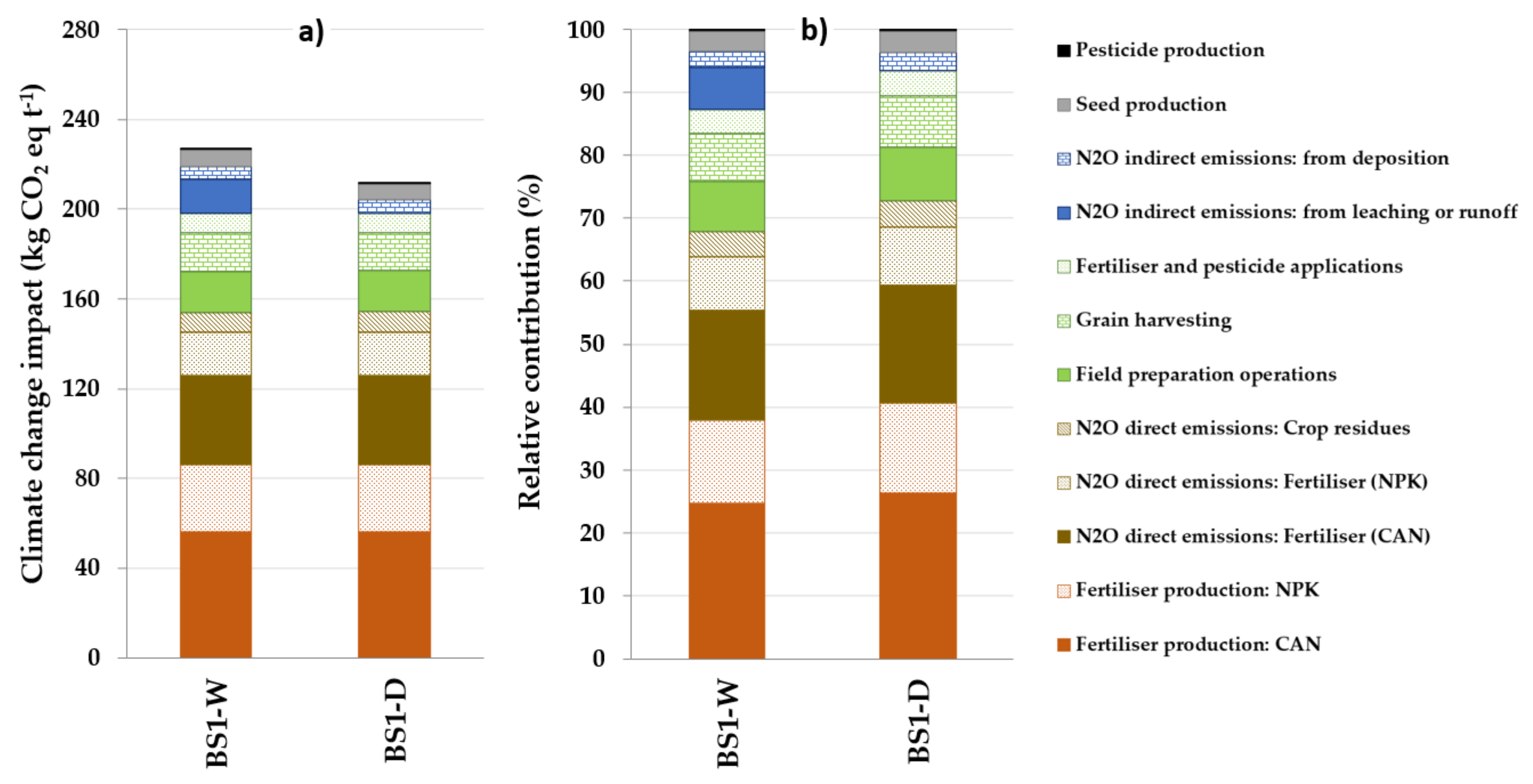

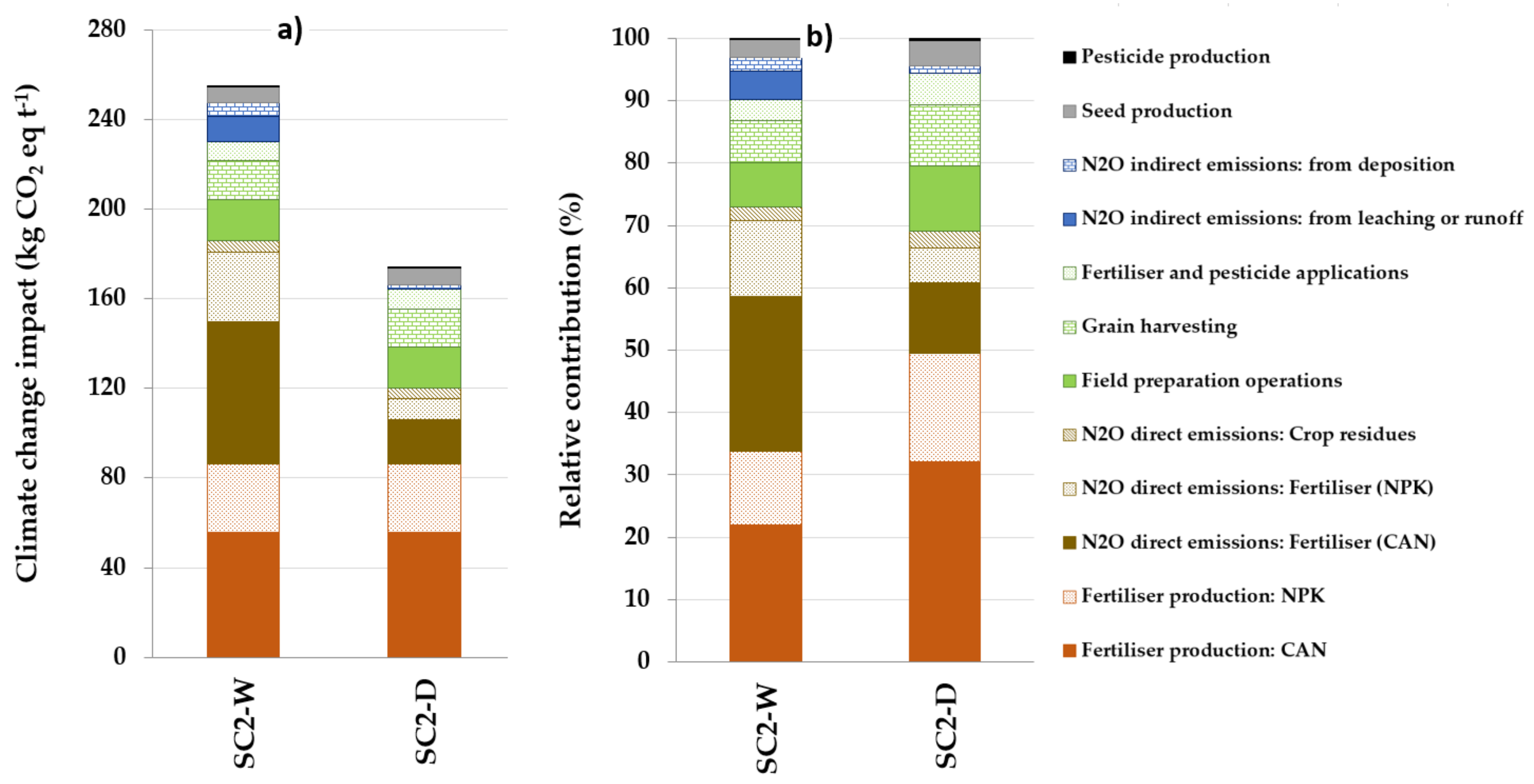
| Category | Farm | Unit | Input Rates | Ecoinvent Process 1 |
|---|---|---|---|---|
| Yield | Grain yield (0.85 DM) | kg ha−1 | 6207 | |
| Straw yield | 6331 | |||
| Seed production | Barley seed for sowing | kg ha−1 | 228 | Barley grain, seed, at farm/ES |
| Fertilisers | Calcium ammonium nitrate (CAN, 26.5% N) | kg ha−1 | 400 | CAN at a regional storehouse in 25 kg containers, including an associated transport and packaging material—RER |
| NPK mixture (13-20-6) | 400 | NPK mixture is considered as (NPK 15-15-15) (13-20-6 unavailable in the database) at a regional storehouse in 25 kg containers, including an associated transport and packaging material—RER | ||
| Pesticides | Pesticide, unspecified | kg (a.i.) 2 ha−1 | 0.48 | Market for pesticide, unspecified—GLO As glyphosate |
| Agricultural field operations | Ploughing + harrowing + sowing | kg ha−1 | 31.29 | Diesel, burned in agricultural machinery {GLO}| market, Alloc Rec, S, (kg fuel) 1 kg diesel burned (corresponds to 45 MJ diesel) |
| Mineral fertilisation + weed disease pest control | 29.36 | |||
| Grain harvesting | 14.64 |
| Emission Factor | IPCC (2006) | IPCC (2019) | Equations |
|---|---|---|---|
| EF1 | 0.01 | Synthetic fertiliser inputs in (W): 0.016 | N2O direct emissions: N2O = (FSN + FCR) × EF1 × 44/28 N2O indirect emissions N2O(ATD) = (FSN × FracGASF) × EF4 × 44/28 N2O(L) = (FSN + FCR) × FracLEACH × EF5 |
| Other N inputs in (W): 0.006 | |||
| All N inputs in (D): 0.005 | |||
| EF4 | 0.01 | 0.014 (W)–0.005 (D) | |
| EF5 | 0.0075 | 0.011 | |
| FracGASF | 0.10 | Ammonium-based: 0.08 Nitrate-based: 0.01 Ammonium nitrate-based: 0.05 | |
| FracLEACH-(H) | 0.30 | 0.24 |
| Emission Factor | IPCC Method | Emission Factor | Equation |
|---|---|---|---|
| NO3− | 2006 | 1.33 kg NO3− kg−1 N applied | kg NO3− = kg N × FracLEACH |
| NO3− | 2019 | 1.06 kg NO3− kg−1 N applied | kg NO3− = kg N × FracLEACH |
| NH3 | 2006–2019 | CAN-0.017 kg NH3 kg−1 N applied NPK-0.091 kg NH3 kg−1 N applied | CAN NPK mixtures |
| NO | 2006–2019 | CAN-0.016 kg NO–N kg−1 N applied NPK-0.0225 kg NO–N kg−1 N applied | |
| Phosphate (PO43−) | 2006–2019 | Pgw = 0.07 kg P ha−1 year−1 | Leaching to groundwater Pgw = Pgwl × Fgw Run-off |
| Pro = 0.175 kg P ha−1 year−1 | Pro = Prol × Fro Fro = 1 + (0.2/80 × P2O5 min) | ||
| Pesticide | 2006–2019 | 10% of the active ingredient was released to the air, 8.5% to water, 76.5% to soil, and the rest (5%) was kept on the crop. | |
| Scenarios | IPCC Guidelines | Allocation Method | Climatic Region |
|---|---|---|---|
| Baseline (BS1) | IPCC 2006 | Mass-based 1 | Wet and dry |
| SC1 3 | IPCC 2006 | Economic 2 | Wet and dry |
| SC2 | IPCC 2019 | Mass-based | Wet and dry |
| SC3 | IPCC 2019 | Economic | Wet and dry |
Publisher’s Note: MDPI stays neutral with regard to jurisdictional claims in published maps and institutional affiliations. |
© 2021 by the authors. Licensee MDPI, Basel, Switzerland. This article is an open access article distributed under the terms and conditions of the Creative Commons Attribution (CC BY) license (https://creativecommons.org/licenses/by/4.0/).
Share and Cite
del Hierro, Ó.; Gallejones, P.; Besga, G.; Artetxe, A.; Garbisu, C. A Comparison of IPCC Guidelines and Allocation Methods to Estimate the Environmental Impact of Barley Production in the Basque Country through Life Cycle Assessment (LCA). Agriculture 2021, 11, 1005. https://doi.org/10.3390/agriculture11101005
del Hierro Ó, Gallejones P, Besga G, Artetxe A, Garbisu C. A Comparison of IPCC Guidelines and Allocation Methods to Estimate the Environmental Impact of Barley Production in the Basque Country through Life Cycle Assessment (LCA). Agriculture. 2021; 11(10):1005. https://doi.org/10.3390/agriculture11101005
Chicago/Turabian Styledel Hierro, Óscar, Patricia Gallejones, Gerardo Besga, Ainara Artetxe, and Carlos Garbisu. 2021. "A Comparison of IPCC Guidelines and Allocation Methods to Estimate the Environmental Impact of Barley Production in the Basque Country through Life Cycle Assessment (LCA)" Agriculture 11, no. 10: 1005. https://doi.org/10.3390/agriculture11101005
APA Styledel Hierro, Ó., Gallejones, P., Besga, G., Artetxe, A., & Garbisu, C. (2021). A Comparison of IPCC Guidelines and Allocation Methods to Estimate the Environmental Impact of Barley Production in the Basque Country through Life Cycle Assessment (LCA). Agriculture, 11(10), 1005. https://doi.org/10.3390/agriculture11101005






